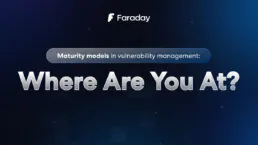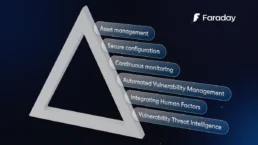Maturity Models in Vulnerability Management: Where Are You At?

Since organizations differ in size, structure, and maturity, there are various vulnerability management models tailored to each. These strategies, adapted to different levels of complexity, are not a one-size-fits-all solution, but rather a set of recommended steps to either build a Vulnerability Management Program (VMP) from the ground up or assess the maturity of an existing VMP. The ultimate goal is to reach a point where vulnerability management no longer feels like a burden, but instead leads to significant improvements in overall security.
VMPs aren’t built or matured overnight. It’s a process that develops over time. Consider these steps as a guide to help you evolve a mature Vulnerability Management Program within your team. Like other areas in cybersecurity, such as zero trust, vulnerability management is an iterative process of continuous improvement, refinement, and learning. Security is ongoing.
This is a two-part article, and we’ll cover the first two levels. Each level of maturity shown in the graph could be expanded in detail, potentially requiring entire books to cover. However, we will distill the key points into a concise guide to help you understand and assess your current position.
Based on the book “Effective Vulnerability Management” by Chris Hughes and Nikki Robinson, we want to share some important questions you should ask:
- Is this step already implemented as described?
- Do I believe our organization’s VMP has reached full maturity with these steps?
- Are there areas where we need to improve our VMP?
- Who within my organization should I consult about each step?
- What step is my team/organization currently at, and can we create a plan to move to the next one?

Let’s begin: Asset Management
The foundation of any effective vulnerability management process is defining the scope of your asset inventory. It starts with understanding which tools are in use and who is responsible for managing them. You’ll also need to ask what methodologies, such as OWASP or Agile, should be incorporated, as well as which standards and compliance requirements need to be met.
If your organization has recently migrated to a multi-cloud environment, it may be time to reassess your inventory needs. Similarly, if you’re undertaking larger, more complex development projects, it’s important to evaluate your CI/CD pipeline and determine which applications and libraries are in use. A thorough analysis of hardware and software across your environment is crucial to ensure complete asset visibility.
At this stage, understanding the human resources you have available is key. An ongoing effort should be to train your team on the use of scanning tools and processes like vulnerability reporting. It’s essential to assign clear ownership of tasks and processes, including how to manage the remediation process.
Daily planning meetings can help keep everyone aligned. Choose the right scanning tools for the initial assessment and decide whether your team composition supports a red team or blue team approach. It’s equally important to cultivate a culture of security awareness by ensuring everyone understands secure practices and knows which sectors are permitted to communicate with third parties.
At the basic level, essential security tools such as endpoint protection (CrowdStrike, Microsoft Defender, etc.) and vulnerability discovery tools like Nmap should be in place. These tools will help identify vulnerabilities within your network. As you move beyond the basics, transition to more advanced tools.
Developing Stage: Establishing a Structured Process
At the developing level, it’s crucial to establish a structured process that includes vulnerability identification, assessment, prioritization, and remediation. This means setting up a system where vulnerabilities are documented, and remediation efforts are prioritized and tracked.
To prioritize vulnerabilities effectively, you should focus on two key factors: risk and exposure. Risk assessment involves determining whether a vulnerability is exploitable and if a patch is available. Exposure relates to how significant the vulnerability is and the potential for exploitation.
Start by assessing whether a vulnerability can be exploited and if a patch exists. Understanding the potential impact and ease of exploitation is vital to gauging the severity of the vulnerability and determining how to prioritize it for remediation.
Secure Configuration
During the development stage, you’ll also need to decide on the regularity and methods of scanning based on your team’s capacity, and whether automation should be introduced into the process. Set scanning frequencies to ensure continuous monitoring and timely identification of vulnerabilities.
In summary, building, and maturing a VMP is an evolving process, requiring continuous reassessment, alignment, and refinement. By assessing your organization’s current maturity level, you can develop a roadmap to achieve a more secure and efficient vulnerability management strategy.
Where do you think you are right now?
Related Posts
September 22, 2025
Lanzamiento Faraday v5.16
¡Bienvenido a la nueva versión de nuestra plataforma de Gestión de Vulnerabilidades! Esta actualización introduce filtros granulares por…
September 22, 2025
Faraday v5.16
Welcome to Faraday v5.16, the new version of our Vulnerability Management platform! This update introduces granular filters by date and…

